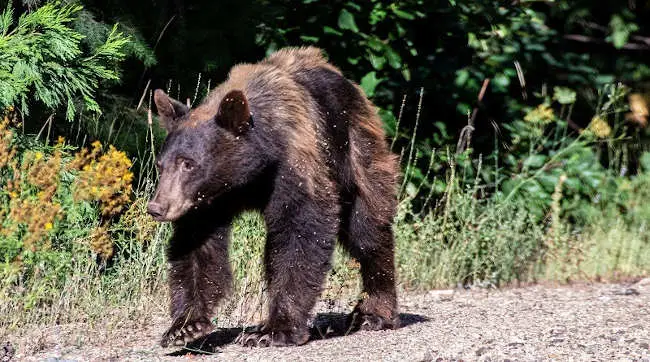
In recent weeks, misinformation about black bears has been circulating online and on flyers posted throughout the Lake Tahoe community.
With all this information swirling, it can be challenging to tell inaccurate information from facts — supported by science. The Tahoe Interagency Bear Team, or TIBT, is here to help.
TIBT is a collective of bear experts across state and local agencies who study and understand these animals and have devoted much of their professional lives to ensure the health and well-being of the Lake Tahoe Basin’s black bears.
TIBT would like to set the record straight by debunking some of those claims and educating the public about the real issues and dangers this misinformation poses.
Tahoe bears may at times seem like a unique bear species due to their general lack of fear and boldness around humans, but these black bears follow the usual biological patterns of black bears across California and Nevada.
Whether living in or visiting bear country in the Lake Tahoe Basin or beyond, this information should clarify what is really needed to help wild bears survive and thrive.
The claim: Bears need human help denning during hibernation
Many have seen photos and videos perpetuating the myth that property owners and residents should allow bears to den under homes and in crawl spaces.
Some may have even seen people encourage this unwanted behavior by laying out hay and other materials for the bears.
But most homeowners don’t even know a bear is under or around their home until it has already established a makeshift den.
Bears will tear out wood and insulation, exposing pipes to freezing temperatures or damaging them in the process. And once a bear gets nice and cozy, it can be difficult to get it out. This increases the chances of human-bear conflict and habituated behavior.
Bears have evolved to comfortably survive winter without human help so it is very important to board up all crawl spaces around homes to discourage bears from setting up camp and damaging property.
The claim: Bears are starving, and people need to feed them
False! Black bears are some of the most resilient and adaptive animals and they can tailor their diet to what is available around them. It is true that bears need a lot of calories, especially in preparation for winter but giving them handouts will not set them up to thrive.
Giving a bear food will teach it to keep coming back and possibly investigate further by breaking into homes, vehicles and garbage bins.
This behavior will also condition cubs to do the same and continue a cycle of human-dependent bears. Human food and garbage are not good for bears and can make them sick and damage their teeth, leaving painful abscesses that can lead to death.
And importantly, feeding bears is illegal in the states of California and Nevada.
Bears instinctively forage on a variety of natural foods including insects, plant material and carrion (dead animals) and have a vital biological role to play in the health of forests, from spreading seeds and fertilizing through their scat to curbing disease and keeping insect populations in check.
If people teach bears to search for food in neighborhoods or other developed areas, that biological role is lost. Even after an incident like the 2021 Caldor Fire, where a huge swath of vegetation was burned, wildlife biologists saw bears find natural ways to survive like the resilient omnivores that they are.
The claim: Bears belong in neighborhoods
It can be exciting to see a big, beautiful animal like a black bear in a neighborhood, but that is not where bears belong. Neighborhoods have roads with cars, which bears must cross in order to get to the unhealthy human food and garbage in developed areas.
By allowing bears to comfortably live in or pass through neighborhoods, the chances that they will get struck and killed by vehicles increases immensely. If a bear is in a neighborhood, encourage it to move on by scaring it away so that it can lead a safe, natural life in the forest.
The claim: Don’t call the experts
TIBT is dedicated to creating the best environment for bears to thrive and remain wild in an ever-growing, ever-changing environment like the Lake Tahoe Basin. The California Department of Fish and Wildlife, or CDFW, and the Nevada Department of Wildlife, or NDOW, should be the first point of contact for any bear-related incidents or questions.
CDFW and NDOW have dedicated and committed black bear experts who will help navigate any human-bear conflicts.
Learn more about keeping Tahoe bears wild at TahoeBears.org and BearWise.org.
To report bear incidents or conflict in the Lake Tahoe Basin, use the following:
• In California, contact CDFW at 916-358-2917 or report online using the Wildlife Incident Reporting (WIR) system at https://apps.wildlife.ca.gov/wir.
• Non-emergency wildlife interactions in California State Parks can be reported to its public dispatch at 916-358-1300.
• In Nevada, contact NDOW at 775-688-BEAR (2327).
• If the issue is an immediate threat, call the local sheriff’s department or 911.


 How to resolve AdBlock issue?
How to resolve AdBlock issue? 




